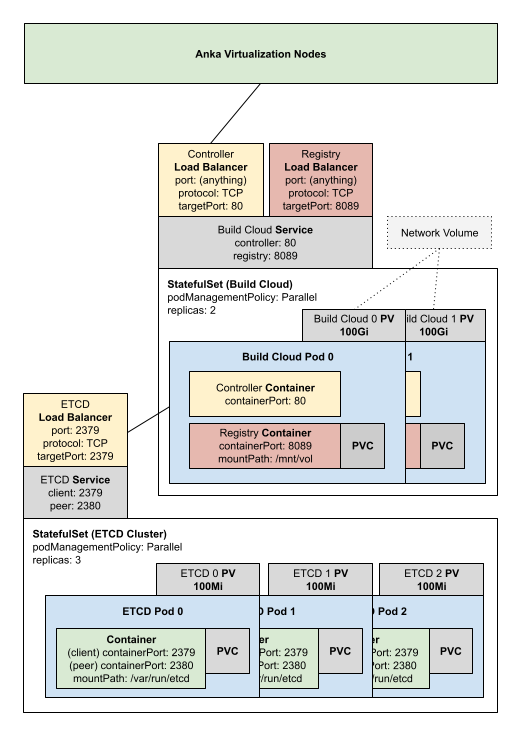With Kubernetes
As the popularity and maturity of Kubernetes grows, we’ve also received an increase of questions from customers on using it to deploy the Build Cloud Controller & Registry. We’ll describe what High Availability looks like for the Anka Build Cloud Controller & Registry software.
There are many ways to deploy your Anka Build Cloud into Kubernetes. Our Getting Started GitHub Repository has a few scripts available to help you run the Anka Build Cloud on your macOS device using minikube. These scripts will generate the necessary YAML you can use to deploy it into your minikube (We cannot guarantee they will work properly outside of minikube and recommend against production use). You may, of course, choose to use Deployments instead of our Statefulsets and even split your controller and registry into separate pods.
The YAML we generate includes:
- A namespace and context for Anka
- 3 ETCD pods
- 2 Build Cloud pods, each with two containers housing the Controller and Registry
- A shared volume for both Registry containers so they see the same VM Templates and Tags
- Load Balancers for each service
Here is a visual diagram for this:

We must mention that the differences between how our customers have deployed Kubernetes (AWS vs. google cloud vs. self-hosted) can require significant changes from the examples we provide. We’ve kept our examples simple to show the configuration and the necessary connections between components. For example, exposing your load balancer for the Controller service on the network may not be required (internal DNS might be available since your CI/CD tool is also inside of Kubernetes). Or, it may require approval and a specific process due to security.
We recommend communicating with your DevOps/Kubernetes team to handle anything missing.
Once it’s up and running, you can join your nodes to the Controller load balancer IP/hostname.
You will also need to expose the Registry load balancer if you want to connect your laptop to push new VM Templates or Tags.
Answers to Frequently Asked Questions
- From our experience, the default nginx ingress controller doesn’t handle large file transfers (pushing your VM template to the registry for example). You will need to tweak the configuration of nginx to allow for large file transfer and so that the default timeouts are not met for long running transfers. Example:
metadata: annotations: nginx.ingress.kubernetes.io/client-max-body-size: "0" nginx.ingress.kubernetes.io/proxy-body-size: "0" nginx.ingress.kubernetes.io/proxy-max-temp-file-size: "0" nginx.ingress.kubernetes.io/proxy-buffering: "off" - When using an AWS NLB, there is an immutable idle connection timeout value of 350s. This can cause registry push/pull actions to timeout. You’ll need to create an ingress ALB that accepts longer connections.
- If the registry pod has resource limits which are hit, it can be rescheduled on another host while it’s performing actions. We recommend avoiding this as much as possible.